一、概述
1. 什么是Netty
1. 简介

内容参考:https://www.jianshu.com/p/b9f3f6a16911
官网:https://netty.io/index.html
Netty 是一个利用 Java 的高级网络的能力,隐藏其背后的复杂性而提供一个易于使用的 API 的客户端/服务器框架。
Netty 是一个广泛使用的 Java 网络编程框架(Netty 在 2011 年获得了Duke’s Choice Award,见 https://www.java.net/dukeschoice/2011)。它活跃和成长于用户社区,像大型公司 Facebook 和 Instagram 以及流行 开源项目如 Infinispan, HornetQ, Vert.x, Apache Cassandra 和 Elasticsearch 等,都利用其强大的对于网络抽象的核心代码。
Netty is an asynchronous event-driven network application framework
for rapid development of maintainable high performance protocol servers & clients.
Netty 是一个异步的、基于事件驱动的网络应用框架,用于快速开发可维护、高性能的网络服务器和客户端
Netty作者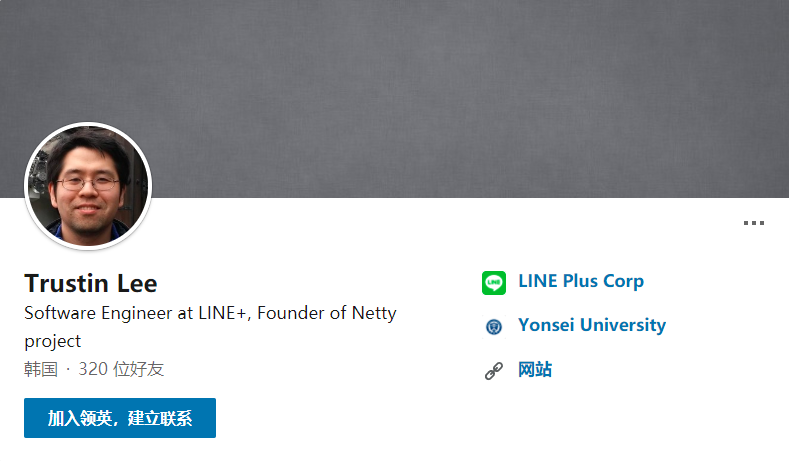
2. Netty的地位
Netty 在 Java 网络应用框架中的地位就好比:Spring 框架在 JavaEE 开发中的地位
以下的框架都使用了 Netty,因为它们有网络通信需求!
- Cassandra - nosql 数据库
- Spark - 大数据分布式计算框架
- Hadoop - 大数据分布式存储框架
- RocketMQ - ali 开源的消息队列
- ElasticSearch - 搜索引擎
- gRPC - rpc 框架
- Dubbo - rpc 框架
- Spring 5.x - flux api 完全抛弃了 tomcat ,使用 netty 作为服务器端
- Zookeeper - 分布式协调框架
3. Netty的优势
Netty vs NIO,工作量大,bug 多
- 需要自己构建协议
- 解决 TCP 传输问题,如粘包、半包
- epoll 空轮询导致 CPU 100%
- 对 API 进行增强,使之更易用,如 FastThreadLocal => ThreadLocal,ByteBuf => ByteBuffer
Netty vs 其它网络应用框架
- Mina 由 apache 维护,将来 3.x 版本可能会有较大重构,破坏 API 向下兼容性,Netty 的开发迭代更迅速,API 更简洁、文档更优秀
- 久经考验,16年,Netty 版本
- 2.x 2004
- 3.x 2008
- 4.x 2013
- 5.x 已废弃(没有明显的性能提升,维护成本高)
2. Netty和Tomcat有什么区别
Netty和Tomcat最大的区别就在于通信协议,Tomcat是基于Http协议的,他的实质是一个基于http协议的web容器,但是Netty不一样,他能通过编程自定义各种协议,因为netty能够通过codec自己来编码/解码字节流,完成类似redis访问的功能,这就是netty和tomcat最大的不同。
有人说netty的性能就一定比tomcat性能高,其实不然,tomcat从6.x开始就支持了nio模式,并且后续还有APR模式——一种通过jni调用apache网络库的模式,相比于旧的bio模式,并发性能得到了很大提高,特别是APR模式,而netty是否比tomcat性能更高,则要取决于netty程序作者的技术实力了
3. 为什么Netty受大众欢迎
如第一部分所述,netty是一款收到大公司青睐的框架,在我看来,netty能够受到青睐的原因有三:
- 并发高
- 传输快
- 封装好
4. Netty为什么并发高
Netty是一款基于NIO(Nonblocking I/O,非阻塞IO)开发的网络通信框架,对比于BIO(Blocking I/O,阻塞IO),他的并发性能得到了很大提高,两张图让你了解BIO和NIO的区别: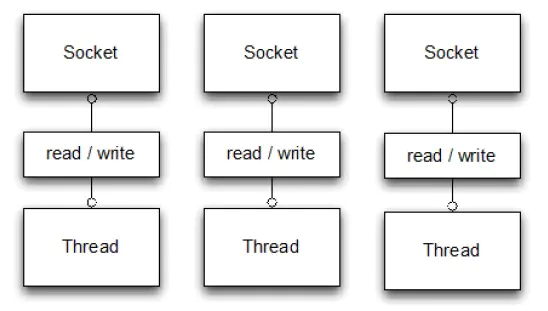
阻塞IO的通信方式
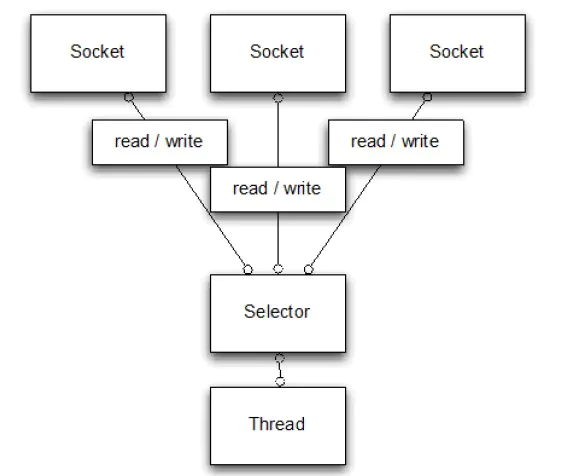
非阻塞IO的通信方式
从这两图可以看出,NIO的单线程能处理连接的数量比BIO要高出很多,而为什么单线程能处理更多的连接呢?原因就是图二中出现的Selector。
当一个连接建立之后,他有两个步骤要做,第一步是接收完客户端发过来的全部数据,第二步是服务端处理完请求业务之后返回response给客户端。NIO和BIO的区别主要是在第一步。
在BIO中,等待客户端发数据这个过程是阻塞的,这样就造成了一个线程只能处理一个请求的情况,而机器能支持的最大线程数是有限的,这就是为什么BIO不能支持高并发的原因。
而NIO中,当一个Socket建立好之后,Thread并不会阻塞去接受这个Socket,而是将这个请求交给Selector,Selector会不断的去遍历所有的Socket,一旦有一个Socket建立完成,他会通知Thread,然后Thread处理完数据再返回给客户端——这个过程是不阻塞的,这样就能让一个Thread处理更多的请求了。
下面两张图是基于BIO的处理流程和netty的处理流程,辅助你理解两种方式的差别: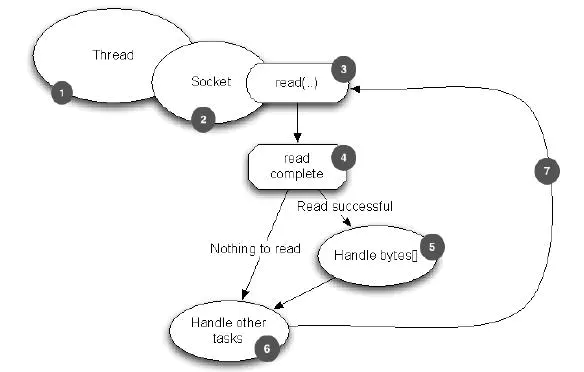
BIO的处理流程
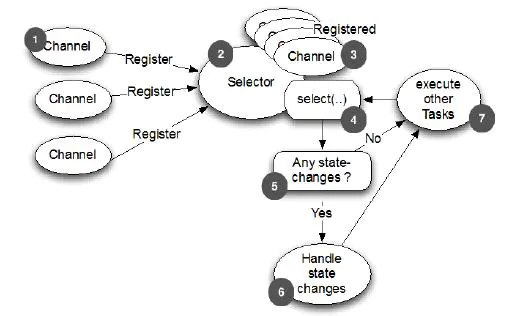
NIO的处理流程
除了BIO和NIO之外,还有一些其他的IO模型,下面这张图就表示了五种IO模型的处理流程: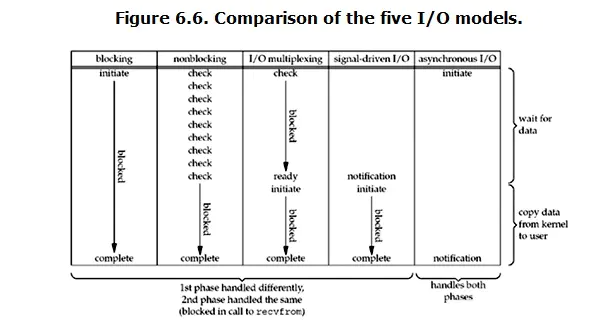
五种常见的IO模型:
- BIO:同步阻塞IO,阻塞整个步骤,如果连接少,他的延迟是最低的,因为一个线程只处理一个连接,适用于少连接且延迟低的场景,比如说数据库连接。
- NIO:同步非阻塞IO,阻塞业务处理但不阻塞数据接收,适用于高并发且处理简单的场景,比如聊天软件。
- 多路复用IO:他的两个步骤处理是分开的,也就是说,一个连接可能他的数据接收是线程a完成的,数据处理是线程b完成的,他比BIO能处理更多请求。
- 信号驱动IO:这种IO模型主要用在嵌入式开发,不参与讨论。
- 异步IO:他的数据请求和数据处理都是异步的,数据请求一次返回一次,适用于长连接的业务场景
以上摘自Linux IO模式及 select、poll、epoll详解
5. Netty为什么传输快
Netty的传输快其实也是依赖了NIO的一个特性——零拷贝。我们知道,Java的内存有堆内存、栈内存和字符串常量池等等,其中堆内存是占用内存空间最大的一块,也是Java对象存放的地方,一般我们的数据如果需要从IO读取到堆内存,中间需要经过Socket缓冲区,也就是说一个数据会被拷贝两次才能到达他的的终点,如果数据量大,就会造成不必要的资源浪费。
Netty针对这种情况,使用了NIO中的另一大特性——零拷贝,当他需要接收数据的时候,他会在堆内存之外开辟一块内存,数据就直接从IO读到了那块内存中去,在netty里面通过ByteBuf可以直接对这些数据进行直接操作,从而加快了传输速度。
下两图就介绍了两种拷贝方式的区别,摘自Linux 中的零拷贝技术,第 1 部分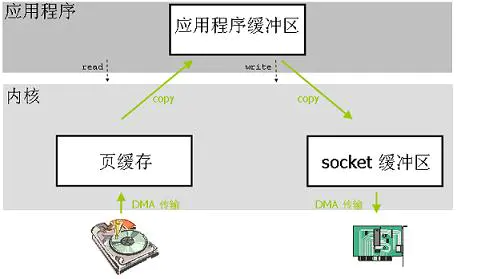
传统数据拷贝
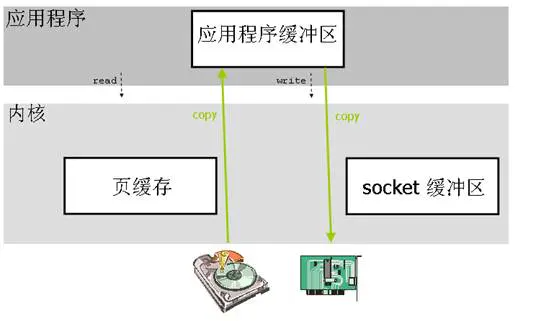
零拷贝
二、入门案例
1. 目标
开发一个简单的服务器端和客户端
- 客户端向服务器端发送 hello, world
- 服务器仅接收,不返回
2. 环境准备
导入netty依赖
<dependency><groupId>io.netty</groupId><artifactId>netty-all</artifactId><version>4.1.39.Final</version></dependency>
3. 服务端
@Slf4j
public class HelloServer {
public static void main(String[] args) {
//1. 启动器:负责组装Netty组件,启动服务器
new ServerBootstrap()
//2. 事件组:BossEventLoop、WorkerEventLoop(Selector, Thread)
.group(new NioEventLoopGroup())
//3. 服务器ServerSocketChannel的实现
.channel(NioServerSocketChannel.class)
//4. 自定义事件处理器:Boss负责处理连接,Worker(child)负责处理读写,决定了Worker(child)能够处理哪些事件(Handle)
.childHandler(
//5. Channel:服务端与客户端之间读写的通道;Initializer:负责添加别的Handle并初始化
new ChannelInitializer<NioSocketChannel>() {
@Override
protected void initChannel(NioSocketChannel nioSocketChannel) {
//6. 添加具体的Handle
nioSocketChannel.pipeline().addLast(new StringDecoder()); //ByteBuf转换为字符串
nioSocketChannel.pipeline().addLast(new ChannelInboundHandlerAdapter(){ //自定义Handle
/**
* 监听读取事件
* @param ctx
* @param msg 客户端发送的数据
*/
@Override
public void channelRead(ChannelHandlerContext ctx, Object msg) throws Exception {
log.debug("READ事件获取的信息:{}", msg);
}
});
}
})
.bind(8080);
}
}
代码解读
- 负责组装Netty组件,启动服务器
- 创建 NioEventLoopGroup,可以简单理解为 线程池 + Selector 后面会详细展开
- 选择服务 Scoket 实现类,其中 NioServerSocketChannel 表示基于 NIO 的服务器端实现,其它实现还有

- 为啥方法叫 childHandler,是接下来添加的处理器都是给 SocketChannel 用的,而不是给 ServerSocketChannel。ChannelInitializer 处理器(仅执行一次),它的作用是待客户端 SocketChannel 建立连接后,执行 initChannel 以便添加更多的处理器
- SocketChannel 的处理器,解码 ByteBuf => String
- SocketChannel 的业务处理器,使用上一个处理器的处理结果
- ServerSocketChannel 绑定的监听端口
4. 客户端
public class HelloClient {
public static void main(String[] args) throws InterruptedException {
new Bootstrap() //1
.group(new NioEventLoopGroup()) //2
.channel(NioSocketChannel.class) //3
.handler(new ChannelInitializer<NioSocketChannel>() { //4
@Override
protected void initChannel(NioSocketChannel nioSocketChannel) throws Exception {
nioSocketChannel.pipeline().addLast(new StringEncoder()); //9
}
})
.connect(new InetSocketAddress("localhost", 8080)) //5
.sync() //6
.channel() //7
.writeAndFlush(new Date() + "Hello World"); //8
}
}
代码解读
- 1 处,启动客户端
- 2 处,创建 NioEventLoopGroup,同 Server
- 3 处,选择客户 Socket 实现类,NioSocketChannel 表示基于 NIO 的客户端实现,其它实现还有

- 4 处,添加 SocketChannel 的处理器,ChannelInitializer 处理器(仅执行一次),它的作用是待客户端 SocketChannel 建立连接后,执行 initChannel 以便添加更多的处理器
- 5 处,指定要连接的服务器和端口
- 6 处,Netty 中很多方法都是异步的,如 connect,这时需要使用 sync 方法等待 connect 建立连接完毕
- 7 处,获取 channel 对象,它即为通道抽象,可以进行数据读写操作
- 8 处,写入消息并清空缓冲区
- 9 处,消息会经过通道 handler 处理,这里是将 String => ByteBuf 发出
数据经过网络传输,到达服务器端,服务器端 5 和 6 处的 handler 先后被触发,走完一个流程
注意:
不论客户端还是服务端 initChannel() 内的代码需要进行连接后才执行
5. 流程数量
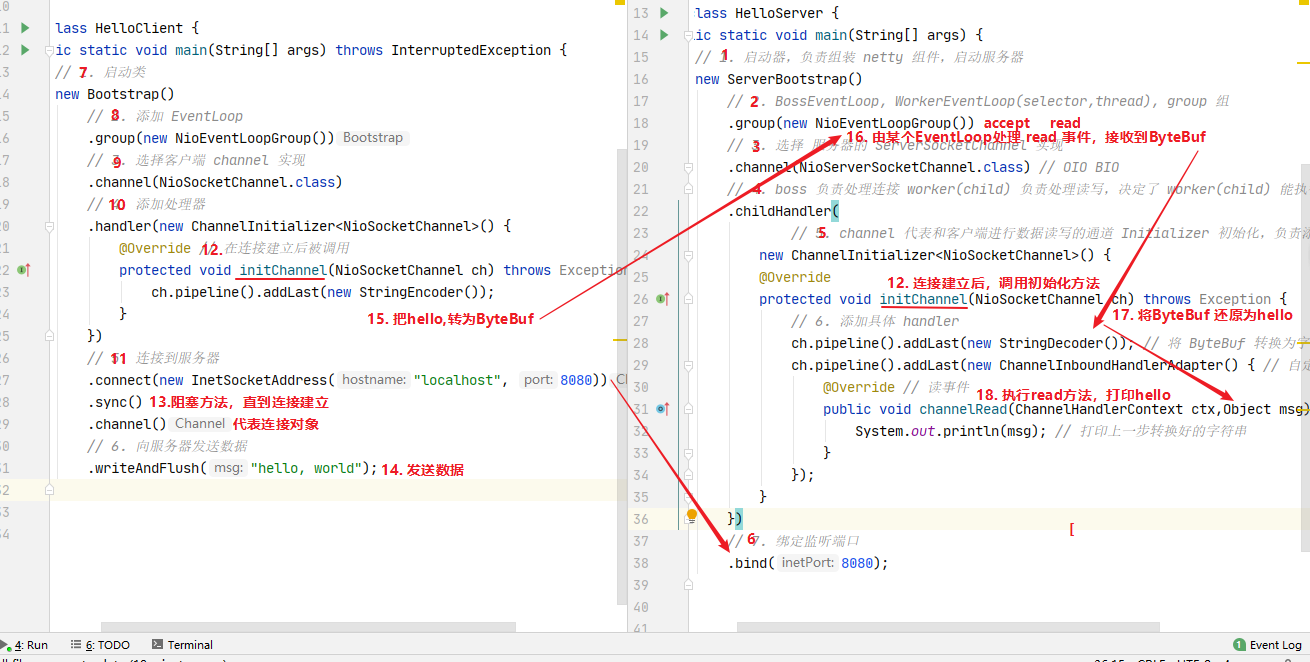
6. 💡提示
一开始需要树立正确的观念
- 把 channel 理解为数据的通道
- 把 msg 理解为流动的数据,最开始输入是 ByteBuf,但经过 pipeline 的加工,会变成其它类型对象,最后输出又变成 ByteBuf
- 把 handler 理解为数据的处理工序
- 工序有多道(类似流水线),合在一起就是 pipeline,pipeline 负责发布事件(读、读取完成…)传播给每个 handler, handler 对自己感兴趣的事件进行处理(重写了相应事件处理方法)
- handler 分 Inbound 和 Outbound 两类
- 把 eventLoop 理解为处理数据的工人
- 工人可以管理多个 channel 的 io 操作,并且一旦工人负责了某个 channel,就要负责到底(绑定)
- 工人既可以执行 io 操作,也可以进行任务处理,每位工人有任务队列,队列里可以堆放多个 channel 的待处理任务,任务分为普通任务、定时任务
- 工人按照 pipeline 顺序,依次按照 handler 的规划(代码)处理数据,可以为每道工序指定不同的工人
三、组件
1. EventLoop
1. 概述
EventLoop:事件循环对象
EventLoop 本质是一个单线程执行器(同时维护了一个 Selector),里面有 run 方法处理 Channel 上源源不断的 io 事件,它的继承关系比较复杂
- 一条线是继承自 java.util.concurrent.ScheduledExecutorService 因此包含了线程池中所有的方法
另一条线是继承自 netty 自己的 io.netty.util.concurrent.OrderedEventExecutor,
继承自 netty 自己的 EventExecutorGroup
- 实现了 Iterable 接口提供遍历 EventLoop 的能力
- 另有 next 方法获取集合中下一个 EventLoop
NioEventLoopGroup:负责处理IO事件、普通任务、定时任务 DefaultEventLoopGroup:负责处理普通任务、定时任务
2. 案例演示EventLoop执行
@Test
public void test01() throws IOException {
//参数指定线程数(不指定就是Cpu线程数的两倍)
EventLoopGroup eventLoopGroup = new NioEventLoopGroup(2);
System.out.println(eventLoopGroup.next());
System.out.println(eventLoopGroup.next());
System.out.println(eventLoopGroup.next());
eventLoopGroup.next().submit(() -> {
try {
Thread.sleep(1000);
} catch (InterruptedException e) {
e.printStackTrace();
}
log.debug("ok1");
});
/*
* param1:执行的线程
* param2:执行的延迟时间
* param3:执行的间隔时间
* param4:时间单位
* */
eventLoopGroup.next().scheduleAtFixedRate(() -> {
try {
Thread.sleep(1000);
} catch (InterruptedException e) {
e.printStackTrace();
}
log.debug("ok2");
}, 0, 1, TimeUnit.SECONDS);
log.debug("main");
System.in.read();
}
输出
io.netty.channel.DefaultEventLoop@60f82f98
io.netty.channel.DefaultEventLoop@35f983a6
io.netty.channel.DefaultEventLoop@60f82f98
也可以使用 for 循环
DefaultEventLoopGroup group = new DefaultEventLoopGroup(2);
for (EventExecutor eventLoop : group) {
System.out.println(eventLoop);
}
输出
io.netty.channel.DefaultEventLoop@60f82f98
io.netty.channel.DefaultEventLoop@35f983a6
3 💡 优雅关闭
优雅关闭 _shutdownGracefully_ 方法。该方法会首先切换 _EventLoopGroup_ 到关闭状态从而拒绝新的任务的加入,然后在任务队列的任务都处理完成后,停止线程的运行。从而确保整体应用是在正常有序的状态下退出的
4. 演示 NioEventLoop 处理 io 事件
案例
服务端
@Slf4j
public class EventLoopServer {
public static void main(String[] args) throws InterruptedException {
new ServerBootstrap()
.group(new NioEventLoopGroup())
.channel(NioServerSocketChannel.class)
.childHandler(new ChannelInitializer<NioSocketChannel>() {
@Override
protected void initChannel(NioSocketChannel ch) {
ch.pipeline().addLast(new ChannelInboundHandlerAdapter() {
@Override
public void channelRead(ChannelHandlerContext ctx, Object msg) {
ByteBuf byteBuf = msg instanceof ByteBuf ? ((ByteBuf) msg) : null;
if (byteBuf != null) {
log.debug(byteBuf.toString(Charset.defaultCharset()));
}
}
});
}
}).bind(8080).sync();
}
}
客户端
public class EventLoopClient {
public static void main(String[] args) throws InterruptedException {
Channel channel = new Bootstrap()
.group(new NioEventLoopGroup())
.channel(NioSocketChannel.class)
.handler(new ChannelInitializer<NioSocketChannel>() {
@Override
protected void initChannel(NioSocketChannel nioSocketChannel) throws Exception {
nioSocketChannel.pipeline().addLast(new StringEncoder());
}
})
.connect(new InetSocketAddress("localhost", 8080))
.sync()
.channel();
//断点在此处运行 channel.writeAndFlush("aaa")
System.out.println("");
}
}
改进点一
服务器端两个 nio worker 工人
boss只负责ServerSocketChannel 上 accept事件;worker只负责socketChannel 上的读写
@Slf4j
public class EventLoopServer {
public static void main(String[] args) throws InterruptedException {
new ServerBootstrap()
//细节一:boss只负责ServerSocketChannel 上 accept事件;worker只负责socketChannel 上的读写
.group(new NioEventLoopGroup(1), new NioEventLoopGroup(2))
.channel(NioServerSocketChannel.class)
.childHandler(new ChannelInitializer<NioSocketChannel>() {
@Override
protected void initChannel(NioSocketChannel ch) {
ch.pipeline().addLast(new ChannelInboundHandlerAdapter() {
@Override
public void channelRead(ChannelHandlerContext ctx, Object msg) {
ByteBuf byteBuf = msg instanceof ByteBuf ? ((ByteBuf) msg) : null;
if (byteBuf != null) {
log.debug(byteBuf.toString(Charset.defaultCharset()));
}
}
});
}
}).bind(8080).sync();
}
}
客户端:启动三次,分别修改发送字符串为 zhangsan(第一次),lisi(第二次),wangwu(第三次)
public class EventLoopClient {
public static void main(String[] args) throws InterruptedException {
Channel channel = new Bootstrap()
.group(new NioEventLoopGroup())
.channel(NioSocketChannel.class)
.handler(new ChannelInitializer<NioSocketChannel>() {
@Override
protected void initChannel(NioSocketChannel nioSocketChannel) throws Exception {
nioSocketChannel.pipeline().addLast(new StringEncoder());
}
})
.connect(new InetSocketAddress("localhost", 8080))
.sync()
.channel();
//断点在此处运行 channel.writeAndFlush("zhangsan")
System.out.println("");
}
}
打印结果
22:03:34 [DEBUG] [nioEventLoopGroup-3-1] c.i.o.EventLoopTest - zhangsan
22:03:36 [DEBUG] [nioEventLoopGroup-3-1] c.i.o.EventLoopTest - zhangsan
22:05:36 [DEBUG] [nioEventLoopGroup-3-2] c.i.o.EventLoopTest - lisi
22:05:38 [DEBUG] [nioEventLoopGroup-3-2] c.i.o.EventLoopTest - lisi
22:06:09 [DEBUG] [nioEventLoopGroup-3-1] c.i.o.EventLoopTest - wangwu
22:06:11 [DEBUG] [nioEventLoopGroup-3-1] c.i.o.EventLoopTest - wangwu
可以看到两个工人轮流处理 channel,但工人与 channel 之间进行了绑定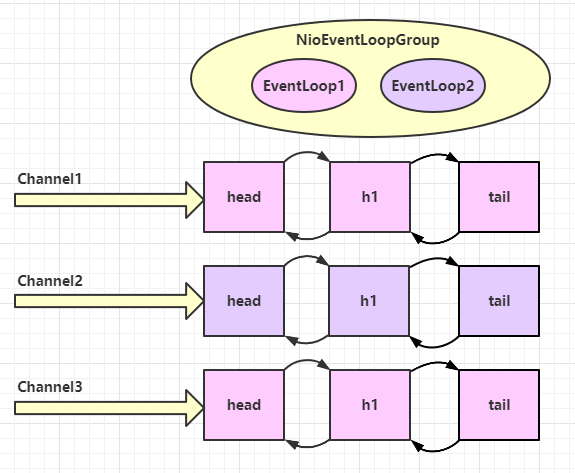
改进点二
当某个Channel中处理的事件较慢时,一定会影响到同一个EventLoop中的其他线程的运行效率;可以多创建一个EventLoop帮助我们处理该次事件
再增加两个非 nio 工人
@Slf4j
public class EventLoopServer {
public static void main(String[] args) throws InterruptedException {
//添加两个非NIO工人(EventLoopGroup)
DefaultEventLoopGroup defaultLoop = new DefaultEventLoopGroup(2);
new ServerBootstrap()
//细节一:boss只负责ServerSocketChannel 上 accept事件;worker只负责socketChannel 上的读写
.group(new NioEventLoopGroup(1), new NioEventLoopGroup(2))
.channel(NioServerSocketChannel.class)
.childHandler(new ChannelInitializer<NioSocketChannel>() {
@Override
protected void initChannel(NioSocketChannel ch) {
ch.pipeline().addLast("handle1", new ChannelInboundHandlerAdapter() {
@Override
public void channelRead(ChannelHandlerContext ctx, Object msg) {
ByteBuf byteBuf = msg instanceof ByteBuf ? ((ByteBuf) msg) : null;
if (byteBuf != null) {
//byte[] buf = new byte[16];
//ByteBuf len = byteBuf.readBytes(buf, 0, byteBuf.readableBytes());
log.debug(byteBuf.toString(Charset.defaultCharset()));
//让消息传递给下一个Handle
ctx.fireChannelRead(msg);
}
}
});
/*
* param1:负责处理事件的EventLoopGroup
* param2:handle名称
* param3:自定义处理事件Handle
* */
ch.pipeline().addLast(defaultLoop, "handle2", new ChannelInboundHandlerAdapter() {
@Override
public void channelRead(ChannelHandlerContext ctx, Object msg) {
ByteBuf byteBuf = msg instanceof ByteBuf ? ((ByteBuf) msg) : null;
if (byteBuf != null) {
//byte[] buf = new byte[16];
//ByteBuf len = byteBuf.readBytes(buf, 0, byteBuf.readableBytes());
log.debug(byteBuf.toString(Charset.defaultCharset()));
}
}
});
}
}).bind(8080).sync();
}
}
客户端不变,启动三次,分别修改发送字符串为 zhangsan(第一次),lisi(第二次),wangwu(第三次)
打印结果
23:40:50 [DEBUG] [nioEventLoopGroup-4-1] c.g.n.EventLoopServer - wangwu
23:40:50 [DEBUG] [defaultEventLoopGroup-2-1] c.g.n.EventLoopServer - wangwu
23:40:53 [DEBUG] [nioEventLoopGroup-4-2] c.g.n.EventLoopServer - zhangsan
23:40:53 [DEBUG] [defaultEventLoopGroup-2-2] c.g.n.EventLoopServer - zhangsan
23:40:54 [DEBUG] [nioEventLoopGroup-4-1] c.g.n.EventLoopServer - lisi
23:40:54 [DEBUG] [defaultEventLoopGroup-2-1] c.g.n.EventLoopServer - lisi
可以看到,nio 工人和 非 nio 工人也分别绑定了 channel(LoggingHandler 由 nio 工人执行,而我们自己的 handler 由非 nio 工人执行)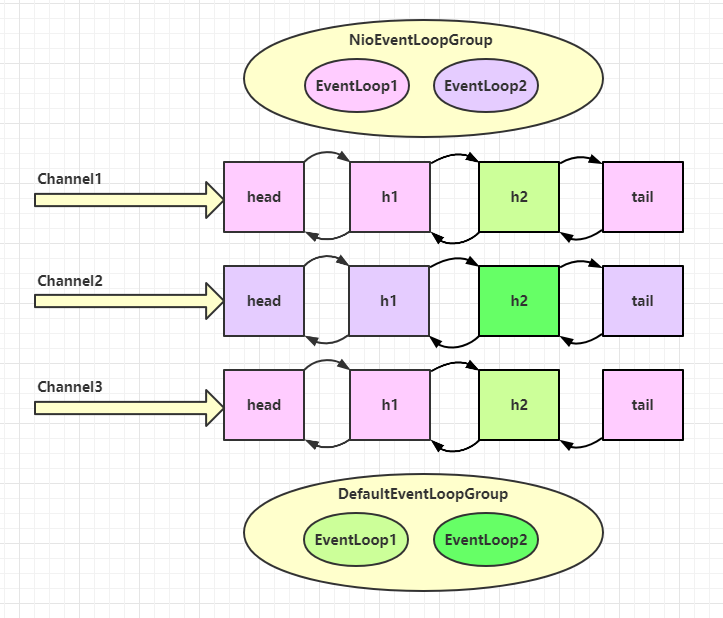
5. 💡 handler 执行中如何换人?
关键代码 _io.netty.channel.AbstractChannelHandlerContext#invokeChannelRead()_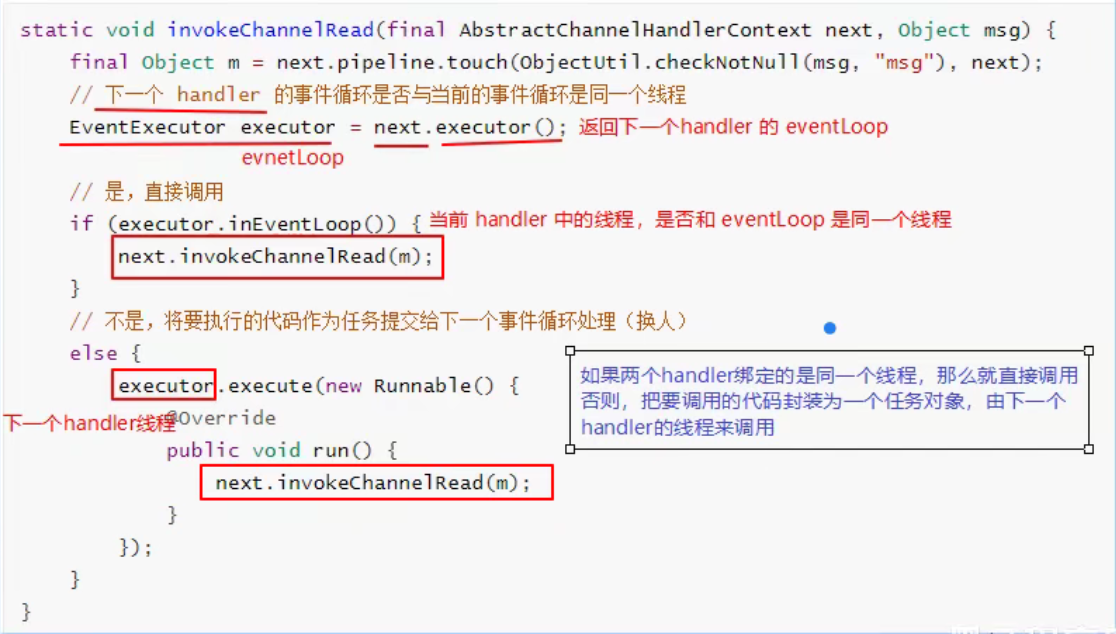
- 如果两个 handler 绑定的是同一个线程,那么就直接调用
- 否则,把要调用的代码封装为一个任务对象,由下一个 handler 的线程来调用
2. Channel
1. 常用方法
channel 的主要作用
- close() 可以用来关闭 channel
- closeFuture() 用来处理 channel 的关闭
- sync 方法作用是同步等待 channel 关闭
- 而 addListener 方法是异步等待 channel 关闭
- pipeline() 方法添加处理器
- write() 方法将数据写入
- writeAndFlush() 方法将数据写入并刷出
2. ChannelFuture
这是刚刚的的客户端代码
new Bootstrap()
.group(new NioEventLoopGroup())
.channel(NioSocketChannel.class)
.handler(new ChannelInitializer<NioSocketChannel>() {
@Override
protected void initChannel(NioSocketChannel nioSocketChannel) throws Exception {
nioSocketChannel.pipeline().addLast(new StringEncoder());
}
})
.connect(new InetSocketAddress("localhost", 8080))
.sync()
.channel();
现在将它拆开来看
ChannelFuture channelFuture = new Bootstrap()
.group(new NioEventLoopGroup())
.channel(NioSocketChannel.class)
.handler(new ChannelInitializer<NioSocketChannel>() {
@Override
protected void initChannel(NioSocketChannel nioSocketChannel) throws Exception {
nioSocketChannel.pipeline().addLast(new StringEncoder());
}
})
//connect() 返回的是 ChannelFuture 对象,它的作用是利用 channel() 方法来获取 Channel 对象
//异步非阻塞方法,main线程发起调用,建立连接的是NIO线程
.connect(new InetSocketAddress("localhost", 8080));
channelFuture.sync();
Channel channel = channelFuture.channel();
channel.writeAndFlush("hello world");
log.debug("{}", channel);
注意: connect 方法是异步的,意味着不等连接建立,方法执行就返回了。因此 channelFuture 对象中不能【立刻】获得到正确的 Channel 对象 补充:带有 Future、Promise 的类型都是和异步方法搭配使用, 用来处理结果
实验如下:
ChannelFuture channelFuture = new Bootstrap()
.group(new NioEventLoopGroup())
.channel(NioSocketChannel.class)
.handler(new ChannelInitializer<NioSocketChannel>() {
@Override
protected void initChannel(NioSocketChannel nioSocketChannel) throws Exception {
nioSocketChannel.pipeline().addLast(new StringEncoder());
}
})
//1. connect()连接到服务器
//异步非阻塞方法,main线程发起调用,建立连接的是NIO线程
.connect(new InetSocketAddress("localhost", 8080));
//使用sync方法同步处理结果,阻塞当前线程,直到NIO线程建立连接完毕
//channelFuture.sync(); //注释该同步代码
Channel channel = channelFuture.channel();
channel.writeAndFlush("hello world");
log.debug("{}", channel);
- 连接未建立,打印 [id: 0x4f009297]
- 查看服务器端未接收到客户端响应的数据
除了用 sync 方法可以让异步操作同步以外,还可以使用回调的方式:
//使用 addListener(回调对象) 方法异步处理结果
channelFuture.addListener(new ChannelFutureListener() {
/**
* @param channelFuture
* @description 在NIO线程将连接建立好之后调用
*/
@Override
public void operationComplete(ChannelFuture channelFuture) throws Exception {
Channel channel = channelFuture.channel();
log.debug("{}", channel);
channel.writeAndFlush("hello world");
}
});
打印结果:
客户端
01:36:15 [DEBUG] [nioEventLoopGroup-2-1] c.g.n.EventLoopClient - [id: 0x90786e4a, L:/127.0.0.1:7384 - R:localhost/127.0.0.1:8080]
发现与服务端已经成功建立了连接,并且是在NIO线程内打印的数据
服务端
01:36:15 [DEBUG] [nioEventLoopGroup-4-2] c.g.n.EventLoopServer - hello world
01:36:15 [DEBUG] [defaultEventLoopGroup-2-2] c.g.n.EventLoopServer - hello world
3. CloseFuture
@Slf4j
public class CloseFutureClient {
public static void main(String[] args) throws InterruptedException {
//取消与服务端的连接需要关闭EventLoopGroup里的线程
NioEventLoopGroup eventLoopGroup = new NioEventLoopGroup();
ChannelFuture channelFuture = new Bootstrap()
.group(eventLoopGroup)
.channel(NioSocketChannel.class)
.handler(new ChannelInitializer<NioSocketChannel>() {
@Override
protected void initChannel(NioSocketChannel nioSocketChannel) throws Exception {
nioSocketChannel.pipeline().addLast(new LoggingHandler(LogLevel.DEBUG));
nioSocketChannel.pipeline().addLast(new StringEncoder());
}
})
//1. connect()连接到服务器
//异步非阻塞方法,main线程发起调用,建立连接的是NIO线程
.connect(new InetSocketAddress("localhost", 8080));
//使用 addListener(回调对象) 方法异步处理结果
channelFuture.addListener(new ChannelFutureListener() {
/**
* @param channelFuture
* @description 在NIO线程将连接建立好之后调用
*/
@Override
public void operationComplete(ChannelFuture channelFuture) throws Exception {
Channel channel = channelFuture.channel();
new Thread(() -> {
while (true){
System.out.print("请输入:");
String input = new Scanner(System.in).next();
if ("q".equals(input)){
//channel.close()是一个异步方法
channel.close();
//在这里进行关闭之后操作,可能会导致线程执行先后问题
//log.debug("处理关闭之后的操作");
break;
}
channel.writeAndFlush(input);
}
}, "input").start();
// 获取 CloseFuture 对象
ChannelFuture closeFuture = channel.closeFuture();
//1.同步处理关闭(存在问题)
// log.debug("waiting close...");
// closeFuture.sync();
// log.debug("处理关闭之后的操作");
// eventLoopGroup.shutdownGracefully();
//2.异步处理关闭
closeFuture.addListener((ChannelFutureListener) channelFuture2 -> {
log.debug("处理关闭之后的操作");
eventLoopGroup.shutdownGracefully();
});
}
});
}
}
- channel.close():关闭与服务端的连接(该方法是异步执行所以往后执行的代码会存在问题)
- channel.closeFuture():获取一个监听关闭事件的ChannelFuture(可使用其进行同步阻塞/异步非阻塞的结果处理)
💡补充:
关闭与服务端的连接后,由于NioEventLoopGroup中任然存在等待的线程所以客户端不会关闭 使用 shutdownGracefully() 方法温和地关闭内部地线程
4. 💡 异步提升的是什么
- 看到这里会有疑问:为什么不在一个线程中去执行建立连接、去执行关闭 channel,那样不是也可以吗?非要用这么复杂的异步方式:比如一个线程发起建立连接,另一个线程去真正建立连接
- 还有同学会笼统地回答,因为 netty 异步方式用了多线程、多线程就效率高。其实这些认识都比较片面,多线程和异步所提升的效率并不是所认为的
思考下面的场景,4 个医生给人看病,每个病人花费 20 分钟,而且医生看病的过程中是以病人为单位的,一个病人看完了,才能看下一个病人。假设病人源源不断地来,可以计算一下 4 个医生一天工作 8 小时,处理的病人总数是:4 * 8 * 3 = 96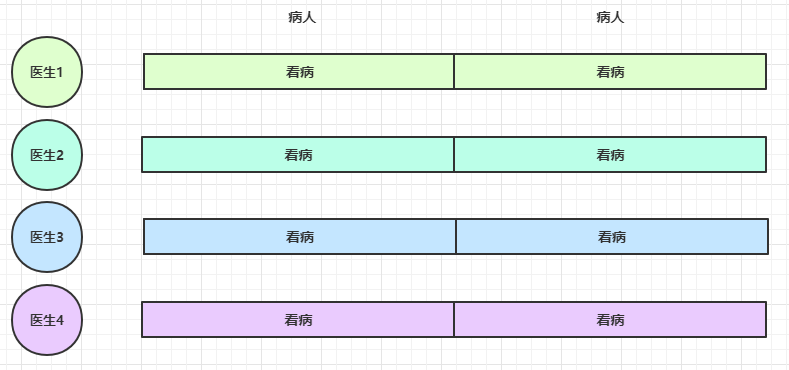
经研究发现,看病可以细分为四个步骤,经拆分后每个步骤需要 5 分钟,如下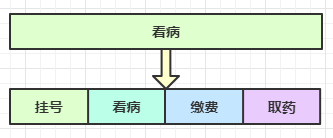
原本一个医生一小时只能处理 3 个病人,任务拆分后一小时可以处理十二个病人。这提升了单位时间的处理任务的吞吐量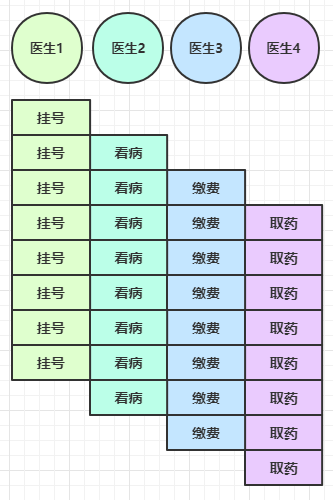
要点
- 单线程没法异步提高效率,必须配合多线程、多核 cpu 才能发挥异步的优势
- 异步并没有缩短响应时间,反而有所增加
- 合理进行任务拆分,也是利用异步的关键
3. Future & Promise
1. 概述
在异步处理时,经常用到这两个接口
首先要说明 netty 中的 Future 与 jdk 中的 Future 同名,但是是两个接口,netty 的 Future 继承自 jdk 的 Future,而 Promise 又对 netty Future 进行了扩展
- jdk Future 只能同步等待任务结束(或成功、或失败)才能得到结果
- netty Future 可以同步等待任务结束得到结果,也可以异步方式得到结果,但都是要等任务结束
- netty Promise 不仅有 netty Future 的功能,而且脱离了任务独立存在,只作为两个线程间传递结果的容器
| 功能/名称 | jdk Future | netty Future | Promise |
|---|---|---|---|
| cancel | 取消任务 | - | - |
| isCanceled | 任务是否取消 | - | - |
| isDone | 任务是否完成,不能区分成功失败 | - | - |
| get | 获取任务结果,阻塞等待 | - | - |
| getNow | - | 获取任务结果,非阻塞,还未产生结果时返回 null | - |
| await | - | 等待任务结束,如果任务失败,不会抛异常,而是通过 isSuccess 判断 | - |
| sync | - | 等待任务结束,如果任务失败,抛出异常 | - |
| isSuccess | - | 判断任务是否成功 | - |
| cause | - | 获取失败信息,非阻塞,如果没有失败,返回null | - |
| addLinstener | - | 添加回调,异步接收结果 | - |
| setSuccess | - | - | 设置成功结果 |
| setFailure | - | - | 设置失败结果 |
2. JDK Future
使用案例
@Slf4j
public class FutureAndPromise {
static void jdkFuture() throws ExecutionException, InterruptedException {
//创建线程池
ExecutorService threadPool = Executors.newCachedThreadPool();
//提交线程任务
Future<?> future = threadPool.submit((Callable<Integer>) () -> {
try {
log.debug("开始计算结果");
Thread.sleep(1000);
} catch (InterruptedException e) {
e.printStackTrace();
}
return 40;
});
log.debug("等待计算结果");
//future.get():阻塞等待结果
log.debug("计算结果={}", future.get());
threadPool.shutdown();
}
}
打印结果
14:15:00 [DEBUG] [main] c.g.n.FutureAndPromise - 等待计算结果
14:15:00 [DEBUG] [pool-1-thread-1] c.g.n.FutureAndPromise - 开始计算结果
14:15:01 [DEBUG] [main] c.g.n.FutureAndPromise - 计算结果=40
仍然是由main线程处理返回结果,所以这里使用的是同步
3. Netty Future
@Slf4j
public class FutureAndPromise {
static void nettyFuture(){
//创建线程组
DefaultEventLoopGroup eventLoopGroup = new DefaultEventLoopGroup(1);
//提交线程任务
io.netty.util.concurrent.Future<Integer> future = eventLoopGroup.submit(() -> {
try {
log.debug("开始计算结果");
Thread.sleep(1000);
} catch (InterruptedException e) {
e.printStackTrace();
}
return 40;
});
//使用Netty Future异步处理返回结果
future.addListener(new GenericFutureListener<io.netty.util.concurrent.Future<? super Integer>>() {
@Override
public void operationComplete(io.netty.util.concurrent.Future<? super Integer> future) throws Exception {
log.debug("得出计算结果={}", future.getNow());
}
});
eventLoopGroup.shutdownGracefully();
}
}
打印计算结果
15:24:37 [DEBUG] [defaultEventLoopGroup-2-1] c.g.n.FutureAndPromise - 开始计算结果
15:24:38 [DEBUG] [defaultEventLoopGroup-2-1] c.g.n.FutureAndPromise - 得出计算结果=40
使用的是defaultEventLoopGroup线程处理返回结果,所以这里使用的是异步
4. Netty Promise
案例一:同步处理任务
@Test
public void nettyPromise1() throws ExecutionException, InterruptedException {
DefaultEventLoop eventExecutors = new DefaultEventLoop();
DefaultPromise<Integer> promise = new DefaultPromise<>(eventExecutors);
eventExecutors.execute(()->{
try {
Thread.sleep(1000);
} catch (InterruptedException e) {
e.printStackTrace();
}
log.debug("set success, {}",10);
promise.setSuccess(10);
});
log.debug("start...");
log.debug("{}",promise.getNow()); // 还没有结果
log.debug("{}",promise.get());
}
打印结果
15:27:05 [DEBUG] [main] c.g.n.FutureAndPromise - start...
15:27:05 [DEBUG] [main] c.g.n.FutureAndPromise - null
15:27:06 [DEBUG] [defaultEventLoop-1-1] c.g.n.FutureAndPromise - set success, 10
15:27:06 [DEBUG] [main] c.g.n.FutureAndPromise - 10
案例二:异步处理任务
@Test
public void nettyPromise2() throws IOException {
DefaultEventLoop eventExecutors = new DefaultEventLoop();
DefaultPromise<Integer> promise = new DefaultPromise<>(eventExecutors);
// 设置回调,异步接收结果
promise.addListener(future -> {
// 这里的 future 就是上面的 promise
log.debug("{}",future.getNow());
});
// 等待 1000 后设置成功结果
eventExecutors.execute(()->{
try {
Thread.sleep(1000);
} catch (InterruptedException e) {
e.printStackTrace();
}
log.debug("set success, {}",10);
promise.setSuccess(10);
});
log.debug("start...");
System.in.read();
}
打印结果
15:53:35 [DEBUG] [main] c.g.n.FutureAndPromise - start...
15:53:36 [DEBUG] [defaultEventLoop-1-1] c.g.n.FutureAndPromise - set success, 10
15:53:36 [DEBUG] [defaultEventLoop-1-1] c.g.n.FutureAndPromise - 10
案例三:同步处理任务失败
Sync
@Test
public void nettyPromise3() throws IOException, ExecutionException, InterruptedException {
DefaultEventLoop eventExecutors = new DefaultEventLoop();
DefaultPromise<Integer> promise = new DefaultPromise<>(eventExecutors);
eventExecutors.execute(() -> {
try {
Thread.sleep(1000);
} catch (InterruptedException e) {
e.printStackTrace();
}
RuntimeException e = new RuntimeException("error...");
log.debug("set failure, {}", e.toString());
promise.setFailure(e);
});
log.debug("start...");
log.debug("{}", promise.getNow());
promise.get(); // sync() 也会出现异常,只是 get 会再用 ExecutionException 包一层异常
System.in.read();
}
打印结果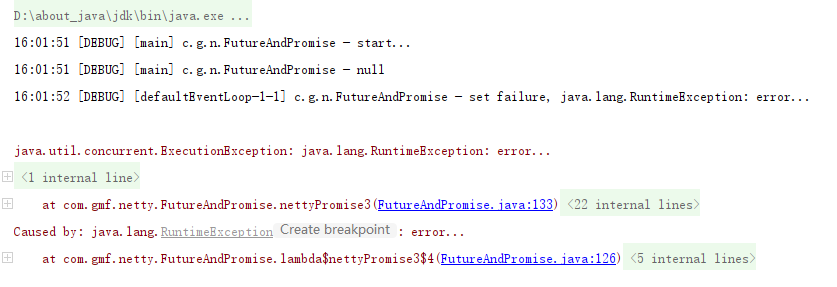
Await
@Test
public void nettyPromise4() throws InterruptedException, IOException {
DefaultEventLoop eventExecutors = new DefaultEventLoop();
DefaultPromise<Integer> promise = new DefaultPromise<>(eventExecutors);
eventExecutors.execute(() -> {
try {
Thread.sleep(1000);
} catch (InterruptedException e) {
e.printStackTrace();
}
RuntimeException e = new RuntimeException("error...");
log.debug("set failure, {}", e.toString());
promise.setFailure(e);
});
log.debug("start...");
log.debug("{}", promise.getNow());
promise.await(); // 与 sync 和 get 区别在于,不会抛异常
log.debug("result {}", (promise.isSuccess() ? promise.getNow() : promise.cause()).toString());
System.in.read();
}
打印结果
案例四:异步处理任务失败
@Test
public void nettyPromise5() throws IOException {
DefaultEventLoop eventExecutors = new DefaultEventLoop();
DefaultPromise<Integer> promise = new DefaultPromise<>(eventExecutors);
promise.addListener(future -> {
log.debug("result {}", (promise.isSuccess() ? promise.getNow() : promise.cause()).toString());
});
eventExecutors.execute(() -> {
try {
Thread.sleep(1000);
} catch (InterruptedException e) {
e.printStackTrace();
}
RuntimeException e = new RuntimeException("error...");
log.debug("set failure, {}", e.toString());
promise.setFailure(e);
});
log.debug("start...");
System.in.read();
}
打印结果
案例五:Await死锁
DefaultEventLoop eventExecutors = new DefaultEventLoop();
DefaultPromise<Integer> promise = new DefaultPromise<>(eventExecutors);
eventExecutors.submit(()->{
System.out.println("1");
try {
promise.await();
// 注意不能仅捕获 InterruptedException 异常
// 否则 死锁检查抛出的 BlockingOperationException 会继续向上传播
// 而提交的任务会被包装为 PromiseTask,它的 run 方法中会 catch 所有异常然后设置为 Promise 的失败结果而不会抛出
} catch (Exception e) {
e.printStackTrace();
}
System.out.println("2");
});
eventExecutors.submit(()->{
System.out.println("3");
try {
promise.await();
} catch (Exception e) {
e.printStackTrace();
}
System.out.println("4");
});
打印结果
1
2
3
4
io.netty.util.concurrent.BlockingOperationException: DefaultPromise@47499c2a(incomplete)
at io.netty.util.concurrent.DefaultPromise.checkDeadLock(DefaultPromise.java:384)
at io.netty.util.concurrent.DefaultPromise.await(DefaultPromise.java:212)
at com.itcast.oio.DefaultPromiseTest.lambda$main$0(DefaultPromiseTest.java:27)
at io.netty.util.concurrent.PromiseTask$RunnableAdapter.call(PromiseTask.java:38)
at io.netty.util.concurrent.PromiseTask.run(PromiseTask.java:73)
at io.netty.channel.DefaultEventLoop.run(DefaultEventLoop.java:54)
at io.netty.util.concurrent.SingleThreadEventExecutor$5.run(SingleThreadEventExecutor.java:918)
at io.netty.util.internal.ThreadExecutorMap$2.run(ThreadExecutorMap.java:74)
at io.netty.util.concurrent.FastThreadLocalRunnable.run(FastThreadLocalRunnable.java:30)
at java.lang.Thread.run(Thread.java:745)
io.netty.util.concurrent.BlockingOperationException: DefaultPromise@47499c2a(incomplete)
at io.netty.util.concurrent.DefaultPromise.checkDeadLock(DefaultPromise.java:384)
at io.netty.util.concurrent.DefaultPromise.await(DefaultPromise.java:212)
at com.itcast.oio.DefaultPromiseTest.lambda$main$1(DefaultPromiseTest.java:36)
at io.netty.util.concurrent.PromiseTask$RunnableAdapter.call(PromiseTask.java:38)
at io.netty.util.concurrent.PromiseTask.run(PromiseTask.java:73)
at io.netty.channel.DefaultEventLoop.run(DefaultEventLoop.java:54)
at io.netty.util.concurrent.SingleThreadEventExecutor$5.run(SingleThreadEventExecutor.java:918)
at io.netty.util.internal.ThreadExecutorMap$2.run(ThreadExecutorMap.java:74)
at io.netty.util.concurrent.FastThreadLocalRunnable.run(FastThreadLocalRunnable.java:30)
at java.lang.Thread.run(Thread.java:745)
5. Handler & Pipeline
ChannelHandler 用来处理 Channel 上的各种事件,分为入站、出站两种。所有 ChannelHandler 被连成一串,就是 Pipeline
- 入站处理器通常是 ChannelInboundHandlerAdapter 的子类,主要用来读取客户端数据,写回结果
- 出站处理器通常是 ChannelOutboundHandlerAdapter 的子类,主要对写回结果进行加工
打个比喻,每个 Channel 是一个产品的加工车间,Pipeline 是车间中的流水线,ChannelHandler 就是流水线上的各道工序,而后面要讲的 ByteBuf 是原材料,经过很多工序的加工:先经过一道道入站工序,再经过一道道出站工序最终变成产品
编写服务端代码,查看执行顺序
@Slf4j
public class PipelineServer {
public static void main(String[] args) {
new ServerBootstrap()
.group(new NioEventLoopGroup())
.channel(NioServerSocketChannel.class)
.childHandler(new ChannelInitializer<NioSocketChannel>() {
@Override
protected void initChannel(NioSocketChannel nioSocketChannel) throws Exception {
ChannelPipeline pipeline = nioSocketChannel.pipeline();
pipeline.addLast("handler1", new ChannelInboundHandlerAdapter(){
@Override
public void channelRead(ChannelHandlerContext ctx, Object msg) throws Exception {
ByteBuf byteBuf = (ByteBuf) msg;
String name = byteBuf.toString(Charset.defaultCharset());
log.debug("handler1处理结果{}", name);
super.channelRead(ctx, name);
}
});
pipeline.addLast("handler2", new ChannelInboundHandlerAdapter(){
@Override
public void channelRead(ChannelHandlerContext ctx, Object msg) throws Exception {
Student student = new Student(msg.toString());
log.debug("handler2处理结果{}", student);
super.channelRead(ctx, student);
}
});
pipeline.addLast("handler3", new ChannelInboundHandlerAdapter(){
@Override
public void channelRead(ChannelHandlerContext ctx, Object msg) throws Exception {
log.debug("handler3处理结果{}", msg.getClass());
//super.channelRead(ctx, msg);
ctx.channel().writeAndFlush(msg);
}
});
pipeline.addLast("outHandler1" ,new ChannelOutboundHandlerAdapter(){
@Override
public void write(ChannelHandlerContext ctx, Object msg,
ChannelPromise promise) {
log.debug("outHandler1接收到数据{}", msg);
ctx.write(msg, promise); // 4
}
});
pipeline.addLast("outHandler2" ,new ChannelOutboundHandlerAdapter(){
@Override
public void write(ChannelHandlerContext ctx, Object msg,
ChannelPromise promise) {
log.debug("outHandler2接收到数据{}", msg);
ctx.write(msg, promise); // 5
}
});
pipeline.addLast("outHandler3" ,new ChannelOutboundHandlerAdapter(){
@Override
public void write(ChannelHandlerContext ctx, Object msg,
ChannelPromise promise) {
log.debug("outHandler3接收到数据{}", msg);
ctx.write(msg, promise); // 6
}
});
}
})
.bind(new InetSocketAddress(8080));
}
static class Student{
String name;
public Student(String name) {
this.name = name;
}
@Override
public String toString() {
return "Student{" +
"name='" + name + '\'' +
'}';
}
}
}
客户端
@Slf4j
public class CloseFutureClient {
public static void main(String[] args) throws InterruptedException {
NioEventLoopGroup eventLoopGroup = new NioEventLoopGroup();
ChannelFuture channelFuture = new Bootstrap()
.group(eventLoopGroup)
.channel(NioSocketChannel.class)
.handler(new ChannelInitializer<NioSocketChannel>() {
@Override
protected void initChannel(NioSocketChannel nioSocketChannel) throws Exception {
nioSocketChannel.pipeline().addLast(new LoggingHandler(LogLevel.DEBUG));
nioSocketChannel.pipeline().addLast(new StringEncoder());
}
})
.connect(new InetSocketAddress("localhost", 8080));
//使用 addListener(回调对象) 方法异步处理结果
channelFuture.addListener(new ChannelFutureListener() {
@Override
public void operationComplete(ChannelFuture channelFuture) throws Exception {
Channel channel = channelFuture.channel();
new Thread(() -> {
while (true){
System.out.print("请输入:");
String input = new Scanner(System.in).next();
if ("q".equals(input)){
channel.close();
break;
}
channel.writeAndFlush(input);
}
}, "input").start();
// 获取 CloseFuture 对象
ChannelFuture closeFuture = channel.closeFuture();
// 异步处理关闭
closeFuture.addListener((ChannelFutureListener) channelFuture2 -> {
log.debug("处理关闭之后的操作");
eventLoopGroup.shutdownGracefully();
});
}
});
}
}
打印结果
17:06:23 [DEBUG] [nioEventLoopGroup-2-2] c.g.n.PipelineServer - handler1处理结果qwe
17:06:23 [DEBUG] [nioEventLoopGroup-2-2] c.g.n.PipelineServer - handler2处理结果Student{name='qwe'}
17:06:23 [DEBUG] [nioEventLoopGroup-2-2] c.g.n.PipelineServer - handler3处理结果class com.gmf.netty.PipelineServer$Student
17:06:23 [DEBUG] [nioEventLoopGroup-2-2] c.g.n.PipelineServer - outHandler3接收到数据Student{name='qwe'}
17:06:23 [DEBUG] [nioEventLoopGroup-2-2] c.g.n.PipelineServer - outHandler2接收到数据Student{name='qwe'}
17:06:23 [DEBUG] [nioEventLoopGroup-2-2] c.g.n.PipelineServer - outHandler1接收到数据Student{name='qwe'}
可以看到,ChannelInboundHandlerAdapter 是按照 addLast 的顺序执行的,而 ChannelOutboundHandlerAdapter 是按照 addLast 的逆序执行的。ChannelPipeline 的实现是一个 ChannelHandlerContext(包装了 ChannelHandler) 组成的双向链表
每次addLast()都是向头尾节点中间添加Handler,这两个节点是Netty中自带的
- super.channelRead(ctx, name) 内部调用 ctx.fireChannelRead(msg)
- ctx.fireChannelRead(msg) 是 调用下一个入站处理器
- ctx.channel().write(msg) 会 从调用链尾部开始触发 后续出站处理器的执行
- ctx.write(msg, promise) 的调用也会 触发上一个出站处理器
ctx.channel().write(msg) VS ctx.write(msg)
- 都是触发出站处理器的执行
- ctx.channel().write(msg) 从尾部开始查找出站处理器
- ctx.write(msg) 是从当前节点找上一个出站处理器
- handler3 执行的 ctx.channel().write(msg) 如果改为 ctx.write(msg) 仅会打印 1 2 3,因为节点3 之前没有其它出站处理器了
- outHandler3 处的 ctx.write(msg, promise) 如果改为 ctx.channel().write(msg) 会打印 1 2 3 6 6 6… 因为 ctx.channel().write() 是从尾部开始查找,结果又是节点6 自己
服务端 pipeline 触发的原始流程,图中数字代表了处理步骤的先后次序
6. EmbeddedChannel基本使用
@Slf4j
public class TestEmbeddedChannel {
public static void main(String[] args) {
ChannelInboundHandlerAdapter h1 = new ChannelInboundHandlerAdapter() {
@Override
public void channelRead(ChannelHandlerContext ctx, Object msg) throws Exception {
log.debug("inHandler1");
super.channelRead(ctx, msg);
}
};
ChannelInboundHandlerAdapter h2 = new ChannelInboundHandlerAdapter() {
@Override
public void channelRead(ChannelHandlerContext ctx, Object msg) throws Exception {
log.debug("inHandler2");
super.channelRead(ctx, msg);
}
};
ChannelOutboundHandlerAdapter h3 = new ChannelOutboundHandlerAdapter() {
@Override
public void write(ChannelHandlerContext ctx, Object msg, ChannelPromise promise) throws Exception {
log.debug("outHandler1");
super.write(ctx, msg, promise);
}
};
ChannelOutboundHandlerAdapter h4 = new ChannelOutboundHandlerAdapter() {
@Override
public void write(ChannelHandlerContext ctx, Object msg, ChannelPromise promise) throws Exception {
log.debug("outHandler2");
super.write(ctx, msg, promise);
}
};
EmbeddedChannel embeddedChannel = new EmbeddedChannel(h1, h2, h3, h4);
//17:37:37 [DEBUG] [main] c.g.n.TestEmbeddedChannel - inHandler1
//17:37:37 [DEBUG] [main] c.g.n.TestEmbeddedChannel - inHandler2
embeddedChannel.writeInbound(ByteBufAllocator.DEFAULT.buffer().writeBytes("InBound".getBytes(StandardCharsets.UTF_8)));
//17:38:37 [DEBUG] [main] c.g.n.TestEmbeddedChannel - outHandler2
//17:38:37 [DEBUG] [main] c.g.n.TestEmbeddedChannel - outHandler1
embeddedChannel.writeOutbound(ByteBufAllocator.DEFAULT.buffer().writeBytes("OutBound".getBytes(StandardCharsets.UTF_8)));
}
}
四、ByteBuf
1. 创建
@Test
public void create(){
ByteBuf buffer = ByteBufAllocator.DEFAULT.buffer();
log(buffer);
StringBuilder s = new StringBuilder();
for (int i = 0; i < 300; i++) {
s.append("a");
}
buffer.writeBytes(s.toString().getBytes(StandardCharsets.UTF_8));
log(buffer);
}
上面代码创建了一个默认的 ByteBuf(池化基于直接内存的 ByteBuf),初始容量是 256
执行结果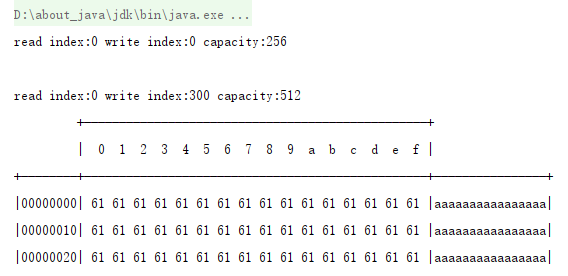
其中 log() 方法参考
private void log(ByteBuf buffer) {
int length = buffer.readableBytes();
int rows = length / 16 + (length % 15 == 0 ? 0 : 1) + 4;
StringBuilder buf = new StringBuilder(rows * 80 * 2)
.append("read index:").append(buffer.readerIndex())
.append(" write index:").append(buffer.writerIndex())
.append(" capacity:").append(buffer.capacity())
.append(NEWLINE); //import static io.netty.util.internal.StringUtil.NEWLINE;
appendPrettyHexDump(buf, buffer); //import static io.netty.buffer.ByteBufUtil.appendPrettyHexDump;
System.out.println(buf);
}
2. 直接内存 vs 堆内存
可以使用下面的代码来创建池化基于堆的 ByteBuf
ByteBuf buffer = ByteBufAllocator.DEFAULT.heapBuffer(10);
也可以使用下面的代码来创建池化基于直接内存的 ByteBuf
ByteBuf buffer = ByteBufAllocator.DEFAULT.directBuffer(10);
- 直接内存创建和销毁的代价昂贵,但读写性能高(少一次内存复制),适合配合池化功能一起用
- 直接内存对 GC 压力小,因为这部分内存不受 JVM 垃圾回收的管理,但也要注意及时主动释放
3. 池化 vs 非池化
池化的最大意义在于可以重用 ByteBuf,优点有
- 没有池化,则每次都得创建新的 ByteBuf 实例,这个操作对直接内存代价昂贵,就算是堆内存,也会增加 GC 压力
- 有了池化,则可以重用池中 ByteBuf 实例,并且采用了与 jemalloc 类似的内存分配算法提升分配效率
- 高并发时,池化功能更节约内存,减少内存溢出的可能
池化功能是否开启,可以通过下面的系统环境变量来设置
-Dio.netty.allocator.type={unpooled|pooled}
- 4.1 以后,非 Android 平台默认启用池化实现,Android 平台启用非池化实现
- 4.1 之前,池化功能还不成熟,默认是非池化实现
配置IDEA虚拟环境变量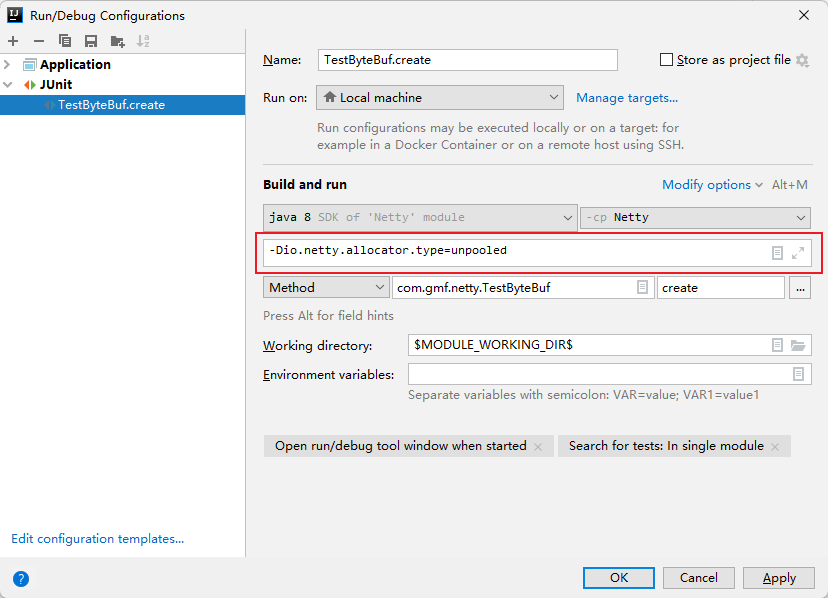
再次查看ByteBuf对象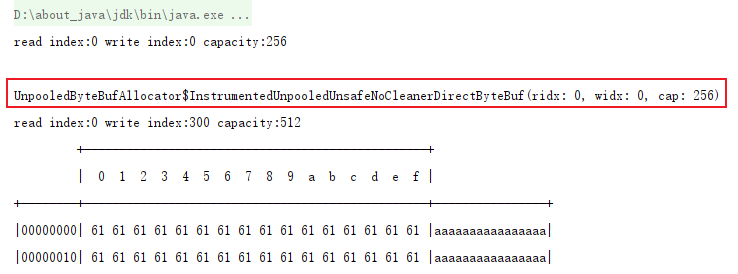
4. ByteBuf的组成
ByteBuf 由四部分组成
最开始读写指针都在0位置
与ByteBuffer相比,读写指针进行了分离,这样就不需要在每次使用前切换读写状态
5. 写入
方法列表,省略一些不重要的方法
| 方法签名 | 含义 | 备注 |
|---|---|---|
| writeBoolean(boolean value) | 写入 boolean 值 | 用一字节 01|00 代表 true|false |
| writeByte(int value) | 写入 byte 值 | |
| writeShort(int value) | 写入 short 值 | |
| writeInt(int value) | 写入 int 值 | Big Endian,即 0x250,写入后 00 00 02 50 |
| writeIntLE(int value) | 写入 int 值 | Little Endian,即 0x250,写入后 50 02 00 00 |
| writeLong(long value) | 写入 long 值 | |
| writeChar(int value) | 写入 char 值 | |
| writeFloat(float value) | 写入 float 值 | |
| writeDouble(double value) | 写入 double 值 | |
| writeBytes(ByteBuf src) | 写入 netty 的 ByteBuf | |
| writeBytes(byte[] src) | 写入 byte[] | |
| writeBytes(ByteBuffer src) | 写入 nio 的 ByteBuffer | |
| int writeCharSequence(CharSequence sequence, Charset charset) | 写入字符串 |
注意
- 这些方法的未指明返回值的,其返回值都是 ByteBuf,意味着可以链式调用
- 网络传输,默认习惯是 Big Endian
先写入 4 个字节
buffer.writeBytes(new byte[]{1, 2, 3, 4});
log(buffer);
结果是
read index:0 write index:4 capacity:10
+-------------------------------------------------+
| 0 1 2 3 4 5 6 7 8 9 a b c d e f |
+--------+-------------------------------------------------+----------------+
|00000000| 01 02 03 04 |.... |
+--------+-------------------------------------------------+----------------+
再写入一个 int 整数,也是 4 个字节
buffer.writeInt(5);
log(buffer);
结果是
read index:0 write index:8 capacity:10
+-------------------------------------------------+
| 0 1 2 3 4 5 6 7 8 9 a b c d e f |
+--------+-------------------------------------------------+----------------+
|00000000| 01 02 03 04 00 00 00 05 |........ |
+--------+-------------------------------------------------+----------------+
还有一类方法是 set 开头的一系列方法,也可以写入数据,但不会改变写指针位置
6. 扩容
再写入一个 int 整数时,容量不够了(初始容量是 10),这时会引发扩容
buffer.writeInt(6);
log(buffer);
扩容规则是
- 如何写入后数据大小未超过 512,则选择下一个 16 的整数倍,例如写入后大小为 12 ,则扩容后 capacity 是 16
- 如果写入后数据大小超过 512,则选择下一个 2^n,例如写入后大小为 513,则扩容后 capacity 是 2^10=1024(2^9=512 已经不够了)
- 扩容不能超过 max capacity 会报错
结果是
read index:0 write index:12 capacity:16
+-------------------------------------------------+
| 0 1 2 3 4 5 6 7 8 9 a b c d e f |
+--------+-------------------------------------------------+----------------+
|00000000| 01 02 03 04 00 00 00 05 00 00 00 06 |............ |
+--------+-------------------------------------------------+----------------+
7. 读取
假设原有12个字符
read index:0 write index:12 capacity:16
+-------------------------------------------------+
| 0 1 2 3 4 5 6 7 8 9 a b c d e f |
+--------+-------------------------------------------------+----------------+
|00000000| 31 32 33 34 35 36 37 38 39 31 30 31 |123456789101 |
+--------+-------------------------------------------------+----------------+
例如读了 4 次,每次一个字节
buffer.readByte();
buffer.readByte();
buffer.readByte();
buffer.readByte();
log(buffer);
如果需要重复读取 int 整数 5,怎么办?可以在 read 前先做个标记 mark
buffer.markReaderIndex();
System.out.println(buffer.readInt());
log(buffer);
打印结果
5
read index:8 write index:12 capacity:16
+-------------------------------------------------+
| 0 1 2 3 4 5 6 7 8 9 a b c d e f |
+--------+-------------------------------------------------+----------------+
|00000000| 00 00 00 06 |.... |
+--------+-------------------------------------------------+----------------+
这时要重复读取的话,重置到标记位置 reset
buffer.resetReaderIndex();
log(buffer);
打印结果
read index:4 write index:12 capacity:16
+-------------------------------------------------+
| 0 1 2 3 4 5 6 7 8 9 a b c d e f |
+--------+-------------------------------------------------+----------------+
|00000000| 00 00 00 05 00 00 00 06 |........ |
+--------+-------------------------------------------------+----------------+
还有种办法是采用 get 开头的一系列方法,这些方法不会改变 read index
8. retain & release
由于 Netty 中有堆外内存的 ByteBuf 实现,堆外内存最好是手动来释放,而不是等 GC 垃圾回收。
- UnpooledHeapByteBuf 使用的是 JVM 内存,只需等 GC 回收内存即可
- UnpooledDirectByteBuf 使用的就是直接内存了,需要特殊的方法来回收内存
- PooledByteBuf 和它的子类使用了池化机制,需要更复杂的规则来回收内存
回收内存的源码实现,请关注下面方法的不同实现
_protected abstract void deallocate()_
Netty 这里采用了引用计数法来控制回收内存,每个 ByteBuf 都实现了 ReferenceCounted 接口
- 每个 ByteBuf 对象的初始计数为 1
- 调用 release 方法计数减 1,如果计数为 0,ByteBuf 内存被回收
- 调用 retain 方法计数加 1,表示调用者没用完之前,其它 handler 即使调用了 release 也不会造成回收
- 当计数为 0 时,底层内存会被回收,这时即使 ByteBuf 对象还在,其各个方法均无法正常使用
谁来负责 release 呢?
不是我们想象的(一般情况下)
ByteBuf buf = ...
try {
...
} finally {
buf.release();
}
请思考,因为 pipeline 的存在,一般需要将 ByteBuf 传递给下一个 ChannelHandler,如果在 finally 中 release 了,就失去了传递性(当然,如果在这个 ChannelHandler 内这个 ByteBuf 已完成了它的使命,那么便无须再传递)
基本规则是,谁是最后使用者,谁负责 release,详细分析如下
- 起点,对于 NIO 实现来讲,在 io.netty.channel.nio.AbstractNioByteChannel.NioByteUnsafe#read 方法中首次创建 ByteBuf 放入 pipeline(line 163 pipeline.fireChannelRead(byteBuf))
- 入站 ByteBuf 处理原则
- 对原始 ByteBuf 不做处理,调用 ctx.fireChannelRead(msg) 向后传递,这时无须 release
- 将原始 ByteBuf 转换为其它类型的 Java 对象,这时 ByteBuf 就没用了,必须 release
- 如果不调用 ctx.fireChannelRead(msg) 向后传递,那么也必须 release
- 注意各种异常,如果 ByteBuf 没有成功传递到下一个 ChannelHandler,必须 release
- 假设消息一直向后传,那么 TailContext 会负责释放未处理消息(原始的 ByteBuf)
- 出站 ByteBuf 处理原则
- 出站消息最终都会转为 ByteBuf 输出,一直向前传,由 HeadContext flush 后 release
- 异常处理原则
- 有时候不清楚 ByteBuf 被引用了多少次,但又必须彻底释放,可以循环调用 release 直到返回 true
TailContext 释放未处理消息逻辑
// io.netty.channel.DefaultChannelPipeline#onUnhandledInboundMessage(java.lang.Object)
protected void onUnhandledInboundMessage(Object msg) {
try {
logger.debug(
"Discarded inbound message {} that reached at the tail of the pipeline. " +
"Please check your pipeline configuration.", msg);
} finally {
ReferenceCountUtil.release(msg);
}
}
HeadContext 释放未处理消息逻辑
//io.netty.channel.DefaultChannelPipeline.HeadContext#write 中调用 io.netty.channel.AbstractChannel.AbstractUnsafe#write
public final void write(Object msg, ChannelPromise promise) {
this.assertEventLoop();
ChannelOutboundBuffer outboundBuffer = this.outboundBuffer;
if (outboundBuffer == null) {
this.safeSetFailure(promise, this.newClosedChannelException(AbstractChannel.this.initialCloseCause));
ReferenceCountUtil.release(msg);
} else {
int size;
try {
msg = AbstractChannel.this.filterOutboundMessage(msg);
size = AbstractChannel.this.pipeline.estimatorHandle().size(msg);
if (size < 0) {
size = 0;
}
} catch (Throwable var6) {
this.safeSetFailure(promise, var6);
ReferenceCountUtil.release(msg);
return;
}
outboundBuffer.addMessage(msg, size, promise);
}
}
ReferenceCountUtil.release(msg)
// io.netty.util.ReferenceCountUtil#release(java.lang.Object)
public static boolean release(Object msg) {
if (msg instanceof ReferenceCounted) {
return ((ReferenceCounted) msg).release();
}
return false;
}
9. ByteBuf零拷贝
1. Slice
零拷贝的体现之一,对原始 ByteBuf 进行切片成多个 ByteBuf,切片后的 ByteBuf 并没有发生内存复制,还是使用原始 ByteBuf 的内存,切片后的 ByteBuf 维护独立的 read,write 指针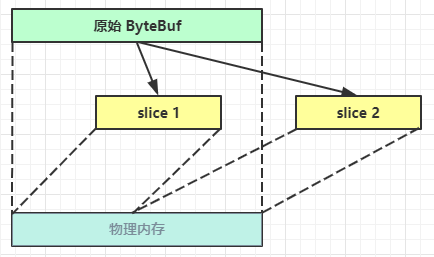
例,原始 ByteBuf 进行一些初始操作
ByteBuf origin = ByteBufAllocator.DEFAULT.buffer(10);
origin.writeBytes(new byte[]{1, 2, 3, 4});
origin.readByte();
System.out.println(ByteBufUtil.prettyHexDump(origin));
输出
+-------------------------------------------------+
| 0 1 2 3 4 5 6 7 8 9 a b c d e f |
+--------+-------------------------------------------------+----------------+
|00000000| 02 03 04 |... |
+--------+-------------------------------------------------+----------------+
这时调用 slice 进行切片,无参 slice 是从原始 ByteBuf 的 read index 到 write index 之间的内容进行切片,切片后的 max capacity 被固定为这个区间的大小,因此不能追加 write
ByteBuf slice = origin.slice();
System.out.println(ByteBufUtil.prettyHexDump(slice));
// slice.writeByte(5); 如果执行,会报 IndexOutOfBoundsException 异常
输出
+-------------------------------------------------+
| 0 1 2 3 4 5 6 7 8 9 a b c d e f |
+--------+-------------------------------------------------+----------------+
|00000000| 02 03 04 |... |
+--------+-------------------------------------------------+----------------+
如果原始 ByteBuf 再次读操作(又读了一个字节)
origin.readByte();
System.out.println(ByteBufUtil.prettyHexDump(origin));
输出
+-------------------------------------------------+
| 0 1 2 3 4 5 6 7 8 9 a b c d e f |
+--------+-------------------------------------------------+----------------+
|00000000| 03 04 |.. |
+--------+-------------------------------------------------+----------------+
这时的 slice 不受影响,因为它有独立的读写指针
System.out.println(ByteBufUtil.prettyHexDump(slice));
输出
+-------------------------------------------------+
| 0 1 2 3 4 5 6 7 8 9 a b c d e f |
+--------+-------------------------------------------------+----------------+
|00000000| 02 03 04 |... |
+--------+-------------------------------------------------+----------------+
如果 slice 的内容发生了更改
slice.setByte(1, 5);
System.out.println(ByteBufUtil.prettyHexDump(slice));
输出
+-------------------------------------------------+
| 0 1 2 3 4 5 6 7 8 9 a b c d e f |
+--------+-------------------------------------------------+----------------+
|00000000| 02 05 04 |... |
+--------+-------------------------------------------------+----------------+
这时,原始 ByteBuf 也会受影响,因为底层都是同一块内存
System.out.println(ByteBufUtil.prettyHexDump(origin));
输出
+-------------------------------------------------+
| 0 1 2 3 4 5 6 7 8 9 a b c d e f |
+--------+-------------------------------------------------+----------------+
|00000000| 05 04 |.. |
+--------+-------------------------------------------------+----------------+
slice(int index, int length) :将ByteBuf从指定索引处切割指定长度的ByteBuf
ByteBuf origin = ByteBufAllocator.DEFAULT.buffer(10);
origin.writeBytes(new byte[]{0, 1, 2, 3, 4, 5, 6, 7, 8, 9});
System.out.println(ByteBufUtil.prettyHexDump(origin));
//使用slice()方法对ByteBuf进行切片
ByteBuf slice1 = origin.slice(0, 5);
ByteBuf slice2 = origin.slice(5, 5);
System.out.println(ByteBufUtil.prettyHexDump(slice1));
System.out.println(ByteBufUtil.prettyHexDump(slice2));
查看输出
+-------------------------------------------------+
| 0 1 2 3 4 5 6 7 8 9 a b c d e f |
+--------+-------------------------------------------------+----------------+
|00000000| 00 01 02 03 04 05 06 07 08 09 |.......... |
+--------+-------------------------------------------------+----------------+
+-------------------------------------------------+
| 0 1 2 3 4 5 6 7 8 9 a b c d e f |
+--------+-------------------------------------------------+----------------+
|00000000| 00 01 02 03 04 |..... |
+--------+-------------------------------------------------+----------------+
+-------------------------------------------------+
| 0 1 2 3 4 5 6 7 8 9 a b c d e f |
+--------+-------------------------------------------------+----------------+
|00000000| 05 06 07 08 09 |..... |
+--------+-------------------------------------------------+----------------+
总结: slice() 方法切割的对象,只是在原有的ByteBuf的上创建出独属的读写指针,并且与原ByteBuf隔离,但本质上还是使用的同一块内存
2. duplicate
零拷贝的体现之一,就好比截取了原始 ByteBuf 所有内容,并且没有 max capacity 的限制,也是与原始 ByteBuf 使用同一块底层内存,只是读写指针是独立的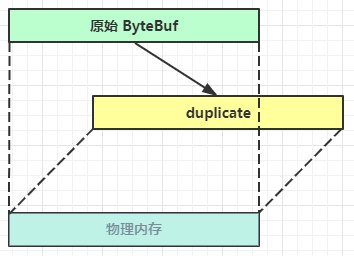
@Test
public void testDuplicate(){
ByteBuf origin = ByteBufAllocator.DEFAULT.buffer(10);
origin.writeBytes(new byte[]{0, 1, 2, 3, 4, 5, 6, 7, 8, 9});
//拷贝一个新对象,在新对象上修改不会影响前对象
ByteBuf duplicate = origin.duplicate();
log(duplicate);
//在origin的基础上新写入内容不会改变origin的内容
duplicate.writeByte(10);
//在origin原有的内容上修改则会改变origin的内容
duplicate.setByte(0, 1);
log(duplicate);
log(origin);
}
打印结果
+-------------------------------------------------+
| 0 1 2 3 4 5 6 7 8 9 a b c d e f |
+--------+-------------------------------------------------+----------------+
|00000000| 00 01 02 03 04 05 06 07 08 09 |.......... |
+--------+-------------------------------------------------+----------------+
read index:0 write index:11 capacity:64
+-------------------------------------------------+
| 0 1 2 3 4 5 6 7 8 9 a b c d e f |
+--------+-------------------------------------------------+----------------+
|00000000| 01 01 02 03 04 05 06 07 08 09 0a |........... |
+--------+-------------------------------------------------+----------------+
read index:0 write index:10 capacity:64
+-------------------------------------------------+
| 0 1 2 3 4 5 6 7 8 9 a b c d e f |
+--------+-------------------------------------------------+----------------+
|00000000| 01 01 02 03 04 05 06 07 08 09 |.......... |
+--------+-------------------------------------------------+----------------+
3. copy
会将底层内存数据进行深拷贝,因此无论读写,都与原始 ByteBuf 无关
4. CompositeByteBuf
零拷贝的体现之一,可以将多个 ByteBuf 合并为一个逻辑上的 ByteBuf,避免拷贝
有两个 ByteBuf 如下
ByteBuf buf1 = ByteBufAllocator.DEFAULT.buffer(5);
buf1.writeBytes(new byte[]{1, 2, 3, 4, 5});
ByteBuf buf2 = ByteBufAllocator.DEFAULT.buffer(5);
buf2.writeBytes(new byte[]{6, 7, 8, 9, 10});
log(buf1);
log(buf2);
现在需要一个新的 ByteBuf,内容来自于刚才的 buf1 和 buf2,如何实现?
方法一
ByteBuf buf3 = ByteBufAllocator.DEFAULT.buffer(buf1.readableBytes()+buf2.readableBytes());
buf3.writeBytes(buf1);
buf3.writeBytes(buf2);
System.out.println(ByteBufUtil.prettyHexDump(buf3));
打印结果
read index:0 write index:10 capacity:10
+-------------------------------------------------+
| 0 1 2 3 4 5 6 7 8 9 a b c d e f |
+--------+-------------------------------------------------+----------------+
|00000000| 01 02 03 04 05 06 07 08 09 0a |.......... |
+--------+-------------------------------------------------+----------------+
这种方法好不好?回答是不太好,因为进行了数据的内存复制操作
方法二
CompositeByteBuf buf4 = ByteBufAllocator.DEFAULT.compositeBuffer();
// true 表示增加新的 ByteBuf 自动递增 write index, 否则 write index 会始终为 0
buf4.addComponents(true, buf1, buf2);
log(buf4);
打印结果
read index:0 write index:10 capacity:10
+-------------------------------------------------+
| 0 1 2 3 4 5 6 7 8 9 a b c d e f |
+--------+-------------------------------------------------+----------------+
|00000000| 01 02 03 04 05 06 07 08 09 0a |.......... |
+--------+-------------------------------------------------+----------------+
注意:被writeBytes()调用过的ByteBuf无法被添加到CompositeByteBuf中
总结
CompositeByteBuf 是一个组合的 ByteBuf,它内部维护了一个 Component 数组,每个 Component 管理一个 ByteBuf,记录了这个 ByteBuf 相对于整体偏移量等信息,代表着整体中某一段的数据
- 优点:对外是一个虚拟视图,组合这些 ByteBuf 不会产生内存复制
- 缺点:复杂了很多,多次操作会带来性能的损耗
5. Unpooled
Unpooled 是一个工具类,类如其名,提供了非池化的 ByteBuf 创建、组合、复制等操作
这里仅介绍其跟【零拷贝】相关的 wrappedBuffer 方法,可以用来包装 ByteBuf
ByteBuf buf1 = ByteBufAllocator.DEFAULT.buffer(5);
buf1.writeBytes(new byte[]{1, 2, 3, 4, 5});
ByteBuf buf2 = ByteBufAllocator.DEFAULT.buffer(5);
buf2.writeBytes(new byte[]{6, 7, 8, 9, 10});
// 当包装 ByteBuf 个数超过一个时, 底层使用了 CompositeByteBuf
ByteBuf buf3 = Unpooled.wrappedBuffer(buf1, buf2);
System.out.println(ByteBufUtil.prettyHexDump(buf3));
输出
+-------------------------------------------------+
| 0 1 2 3 4 5 6 7 8 9 a b c d e f |
+--------+-------------------------------------------------+----------------+
|00000000| 01 02 03 04 05 06 07 08 09 0a |.......... |
+--------+-------------------------------------------------+----------------+
也可以用来包装普通字节数组,底层也不会有拷贝操作
ByteBuf buf4 = Unpooled.wrappedBuffer(new byte[]{1, 2, 3}, new byte[]{4, 5, 6});
System.out.println(buf4.getClass());
System.out.println(ByteBufUtil.prettyHexDump(buf4));
输出
class io.netty.buffer.CompositeByteBuf
+-------------------------------------------------+
| 0 1 2 3 4 5 6 7 8 9 a b c d e f |
+--------+-------------------------------------------------+----------------+
|00000000| 01 02 03 04 05 06 |...... |
+--------+-------------------------------------------------+----------------+
10. ByteBuf优势
- 池化 - 可以重用池中 ByteBuf 实例,更节约内存,减少内存溢出的可能
- 读写指针分离,不需要像 ByteBuffer 一样切换读写模式
- 可以自动扩容
- 支持链式调用,使用更流畅
- 很多地方体现零拷贝,例如 slice、duplicate、CompositeByteBuf
11. 双向通信
练习案例代码
服务端
@Slf4j
public class communicationServer {
public static void main(String[] args) {
new ServerBootstrap()
.group(new NioEventLoopGroup())
.channel(NioServerSocketChannel.class)
.childHandler(new ChannelInitializer<NioSocketChannel>() {
@Override
protected void initChannel(NioSocketChannel ch) {
ch.pipeline().addLast(new ChannelInboundHandlerAdapter(){
@Override
public void channelRead(ChannelHandlerContext ctx, Object msg) {
ByteBuf buffer = (ByteBuf) msg;
log.debug("server:" + buffer.toString(Charset.defaultCharset()));
// 建议使用 ctx.alloc() 创建 ByteBuf
ByteBuf response = ctx.alloc().buffer();
response.writeBytes(buffer);
ctx.writeAndFlush(response);
// 思考:需要释放 buffer 吗
while (!buffer.release()){}
// 思考:需要释放 response 吗
while (!response.release()){}
}
});
}
}).bind(8080);
}
}
客户端
@Slf4j
public class communicationClient {
public static void main(String[] args) throws InterruptedException {
NioEventLoopGroup eventLoopGroup = new NioEventLoopGroup();
Channel channel = new Bootstrap()
.group(eventLoopGroup)
.channel(NioSocketChannel.class)
.handler(new ChannelInitializer<NioSocketChannel>() {
@Override
protected void initChannel(NioSocketChannel ch) throws Exception {
ch.pipeline().addLast(new StringEncoder());
ch.pipeline().addLast(new ChannelInboundHandlerAdapter() {
@Override
public void channelRead(ChannelHandlerContext ctx, Object msg) throws Exception {
ByteBuf buffer = (ByteBuf) msg;
log.debug("client:" + buffer.toString(Charset.defaultCharset()));
}
});
}
})
.connect("localhost", 8080).sync().channel();
channel.closeFuture().addListener(future -> {
eventLoopGroup.shutdownGracefully();
});
new Thread(() -> {
System.out.print("请输入");
Scanner scanner = new Scanner(System.in);
while (true) {
String line = scanner.nextLine();
if ("q".equals(line)) {
channel.close();
break;
}
channel.writeAndFlush(line);
}
}).start();
}
}
💡 读和写的误解
最初在认识上有这样的误区,认为只有在 netty,nio 这样的多路复用 IO 模型时,读写才不会相互阻塞,才可以实现高效的双向通信,但实际上,Java Socket 是全双工的:在任意时刻,线路上存在A 到 B 和 B 到 A 的双向信号传输。即使是阻塞 IO,读和写是可以同时进行的,只要分别采用读线程和写线程即可,读不会阻塞写、写也不会阻塞读
例如:
public class TestServer {
public static void main(String[] args) throws IOException {
ServerSocket ss = new ServerSocket(8888);
Socket s = ss.accept();
new Thread(() -> {
try {
BufferedReader reader = new BufferedReader(new InputStreamReader(s.getInputStream()));
while (true) {
System.out.println(reader.readLine());
}
} catch (IOException e) {
e.printStackTrace();
}
}).start();
new Thread(() -> {
try {
BufferedWriter writer = new BufferedWriter(new OutputStreamWriter(s.getOutputStream()));
// 例如在这个位置加入 thread 级别断点,可以发现即使不写入数据,也不妨碍前面线程读取客户端数据
for (int i = 0; i < 100; i++) {
writer.write(String.valueOf(i));
writer.newLine();
writer.flush();
}
} catch (IOException e) {
e.printStackTrace();
}
}).start();
}
}
客户端
public class TestClient {
public static void main(String[] args) throws IOException {
Socket s = new Socket("localhost", 8888);
new Thread(() -> {
try {
BufferedReader reader = new BufferedReader(new InputStreamReader(s.getInputStream()));
while (true) {
System.out.println(reader.readLine());
}
} catch (IOException e) {
e.printStackTrace();
}
}).start();
new Thread(() -> {
try {
BufferedWriter writer = new BufferedWriter(new OutputStreamWriter(s.getOutputStream()));
for (int i = 0; i < 100; i++) {
writer.write(String.valueOf(i));
writer.newLine();
writer.flush();
}
} catch (IOException e) {
e.printStackTrace();
}
}).start();
}
}

